Tác động của hình ảnh, chất lượng và giá trị tới sự hài lòng của sinh viên theo học các chương trình đào tạo quốc tế tại một số Đại học công lập
Tóm lược
Nghiên cứu có mục đích kiểm chứng và đánh giá mối quan hệ giữa hình ảnh trường đại
học, chất lượng dịch vụ, giá trị dịch vụ và sự hài lòng của sinh viên đối với chương trình đào tạo
quốc tế. Dữ liệu được thu thập từ 856 sinh viên đang theo học các chương trình đào tạo quốc tế
tại một số trường đại học bao gồm trường đại học Thương mại, trường đại học Hà Nội, trường
đại học Công nghiệp Hà Nội. Nghiên cứu sử dụng các phương pháp bao gồm thống kê mô tả,
phân tích EFA, hệ số Cronbach Alpha, CFA và SEM. Kết quả nghiên cứu đã chỉ ra chất lượng
dịch vụ, giá trị dịch vụ và hình ảnh trường đại học có mối liên hệ. Chất lượng dịch vụ và hình
ảnh trường đại học có tác động tới giá trị dịch vụ. Hình ảnh trường đại học cũng chịu tác động
bởi chất lượng dịch vụ và cả 3 yếu tố trên có tác động tới sự hài lòng của sinh viên theo học
chương trình đào tạo quốc tế.
Từ khoá: Chất lượng dịch vụ; Giá trị dịch vụ; Hình ảnh trường đại học; Sự hài lòng của
sinh viên
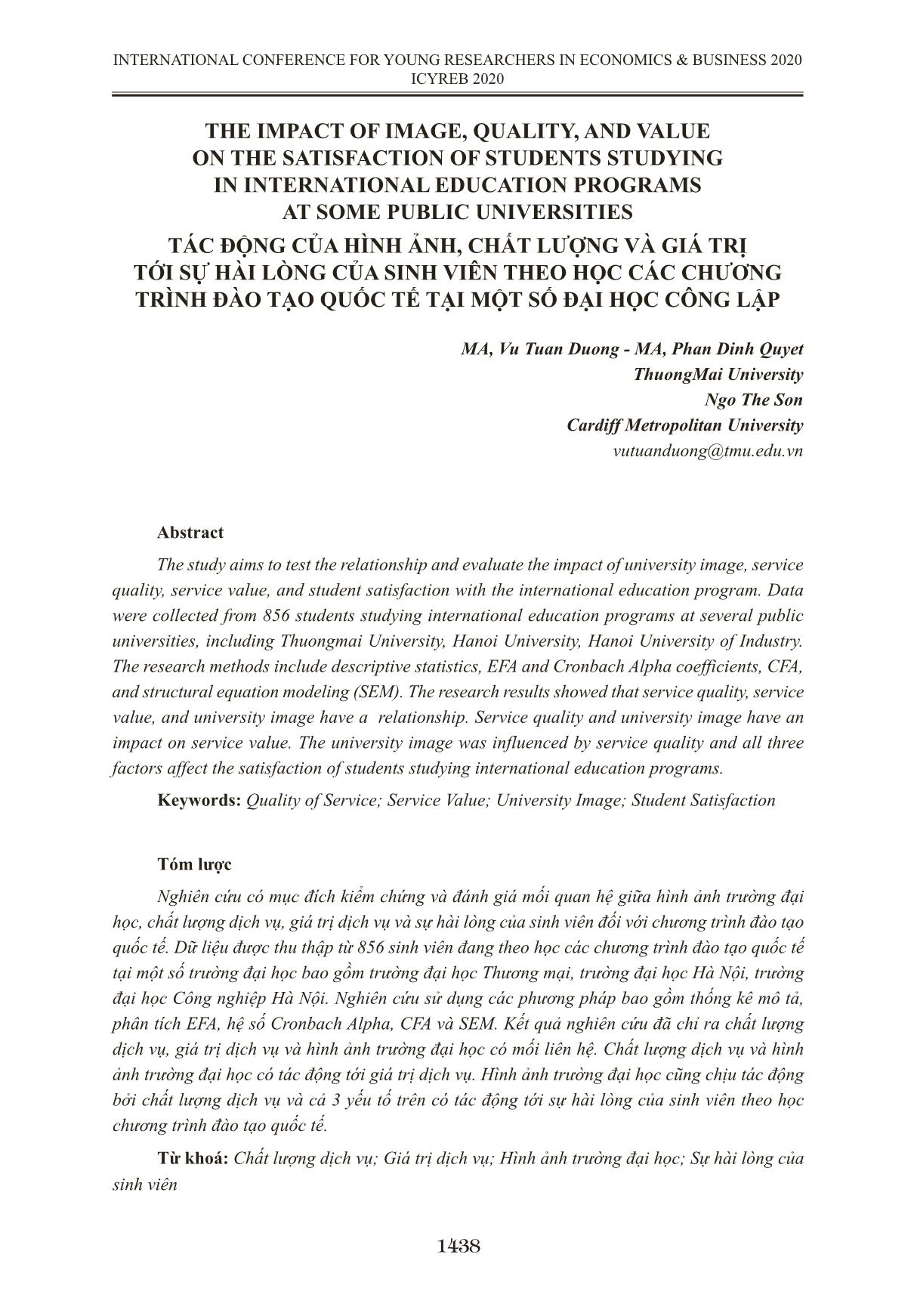
Trang 1
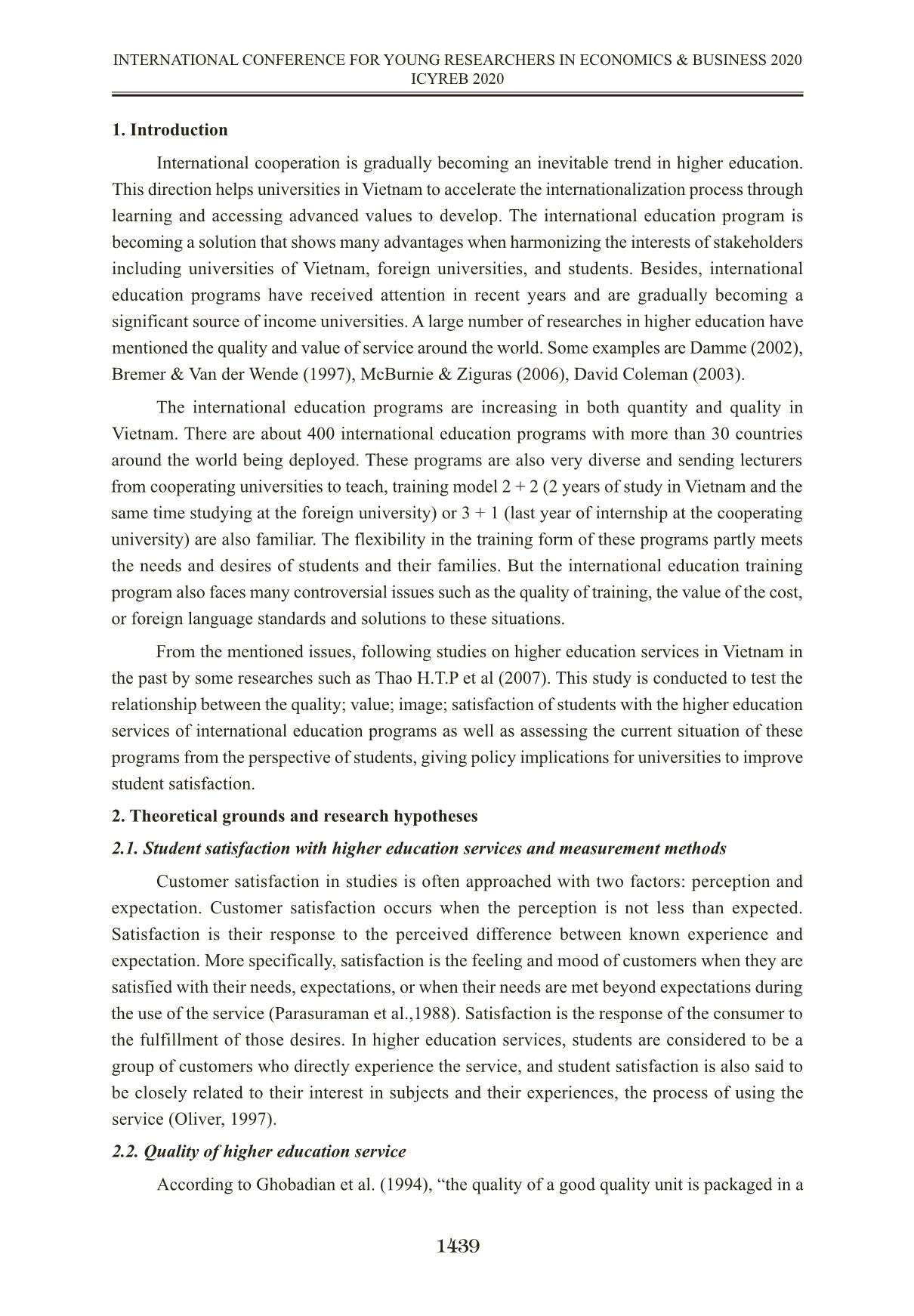
Trang 2
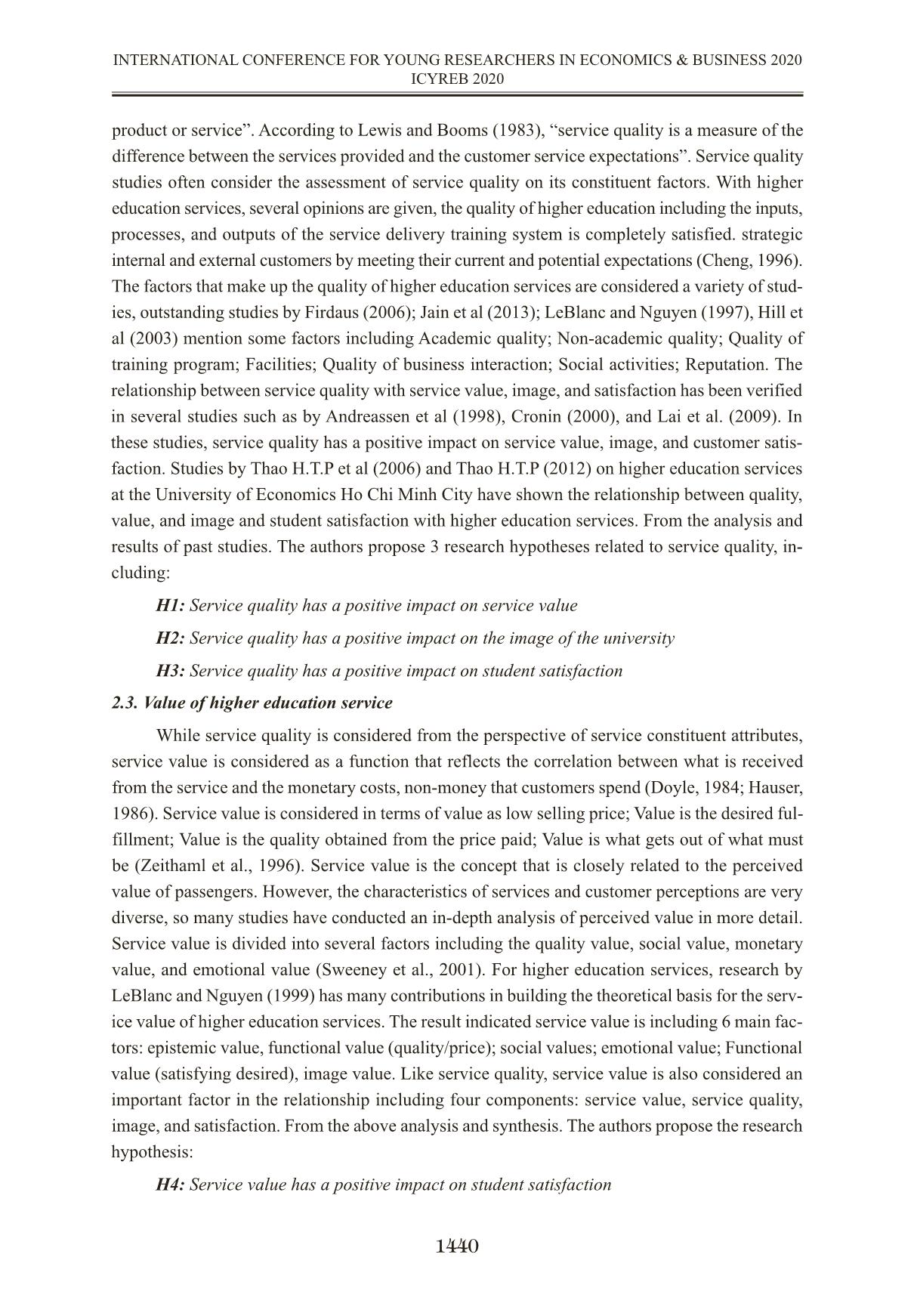
Trang 3
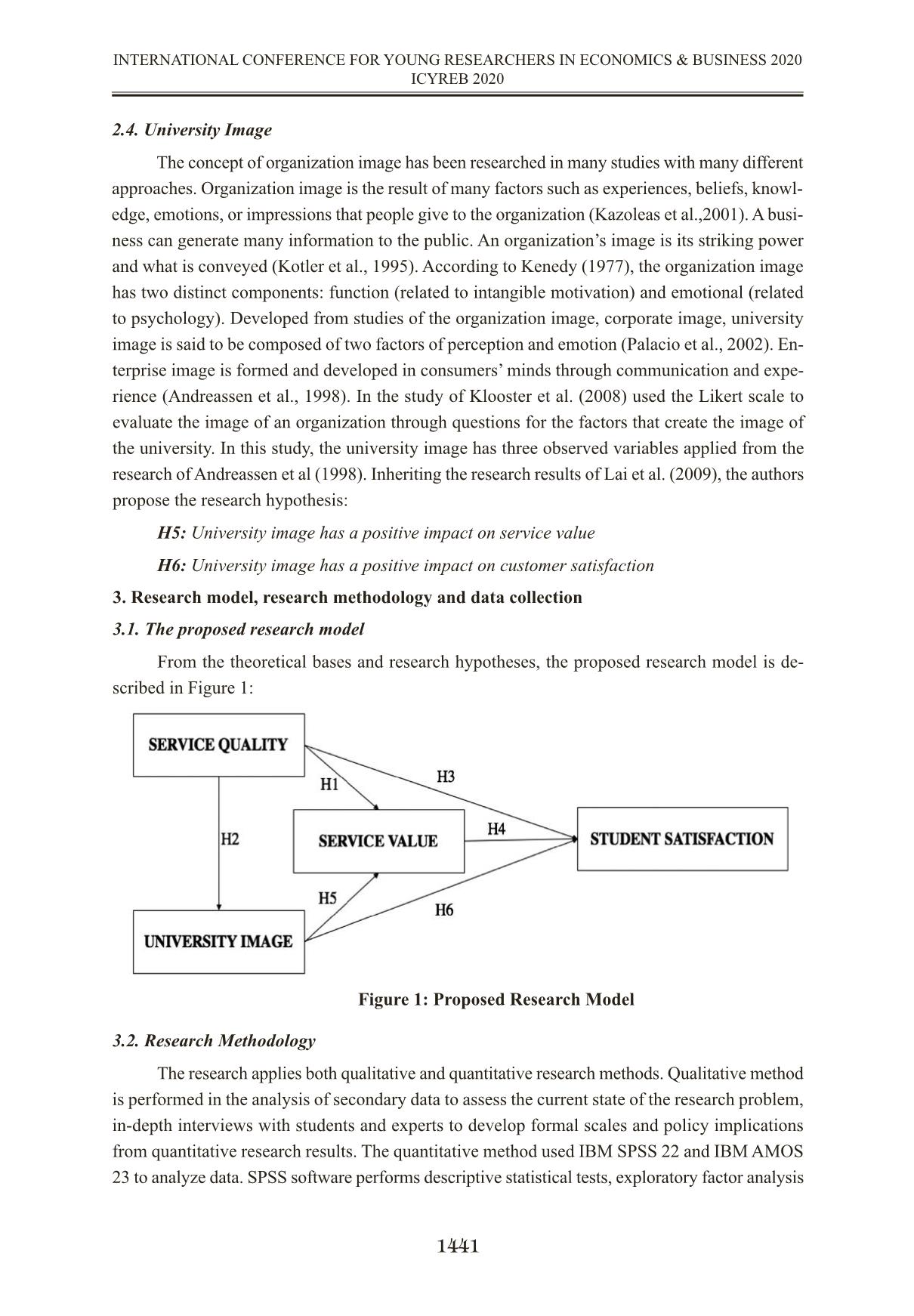
Trang 4
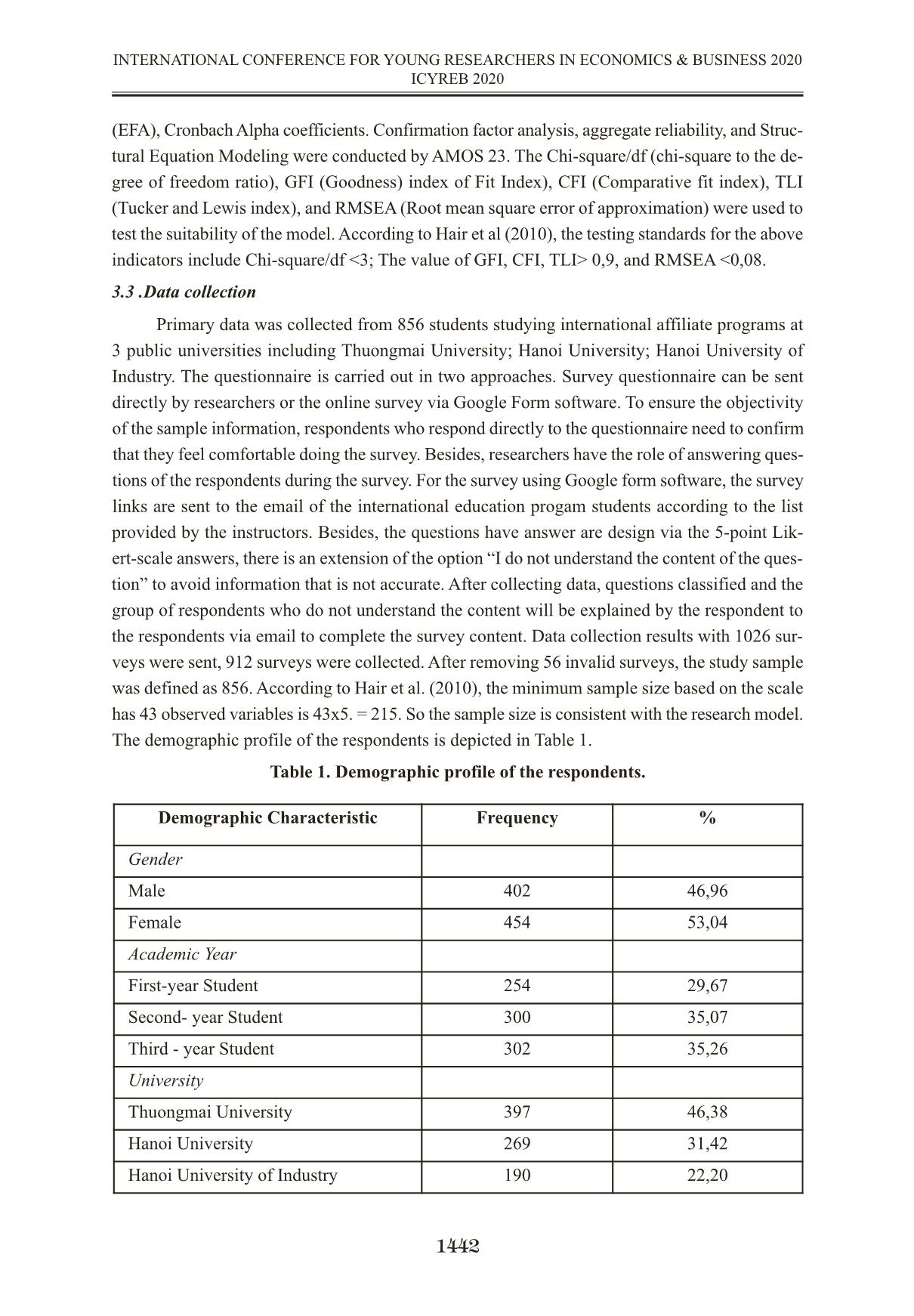
Trang 5
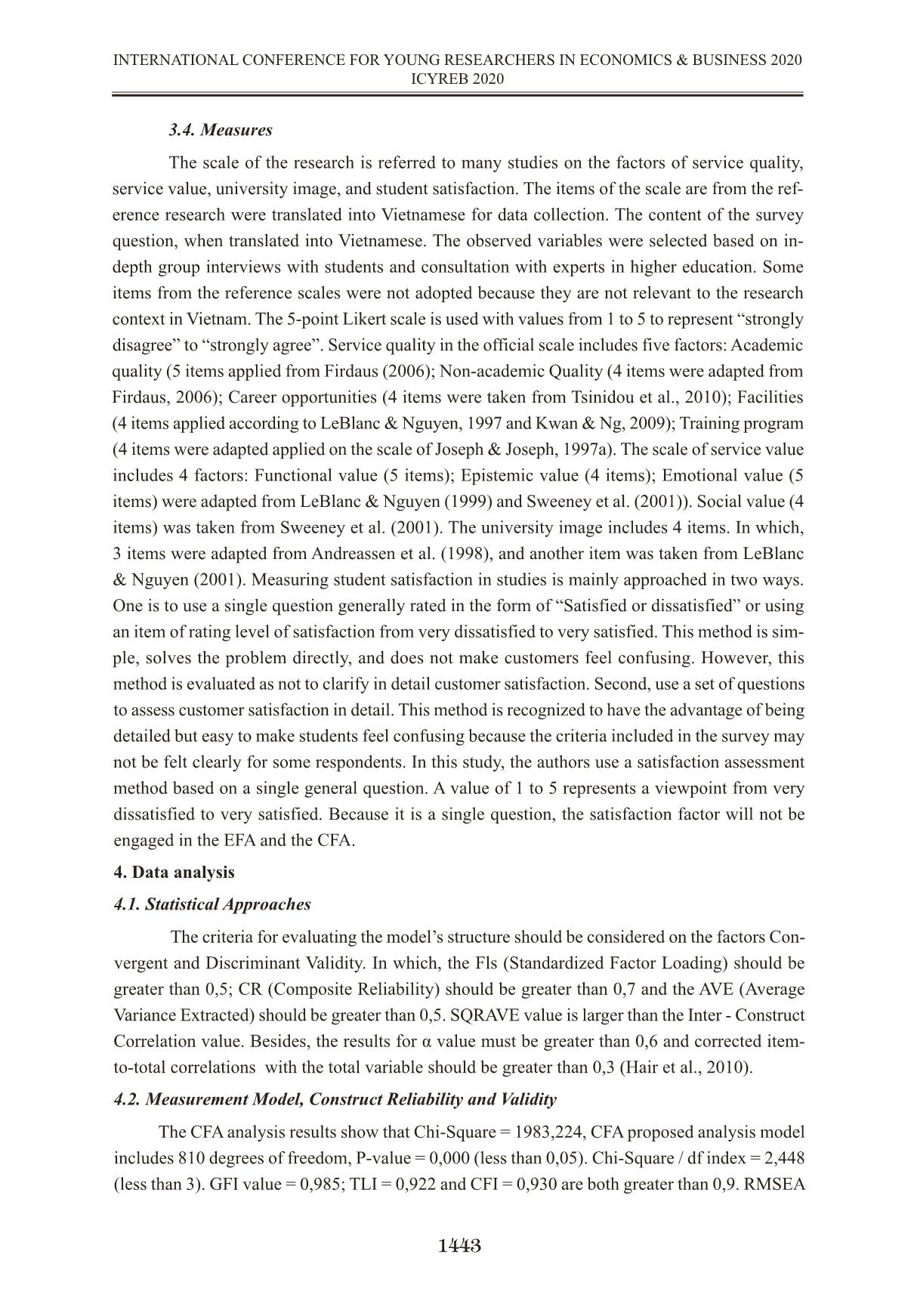
Trang 6
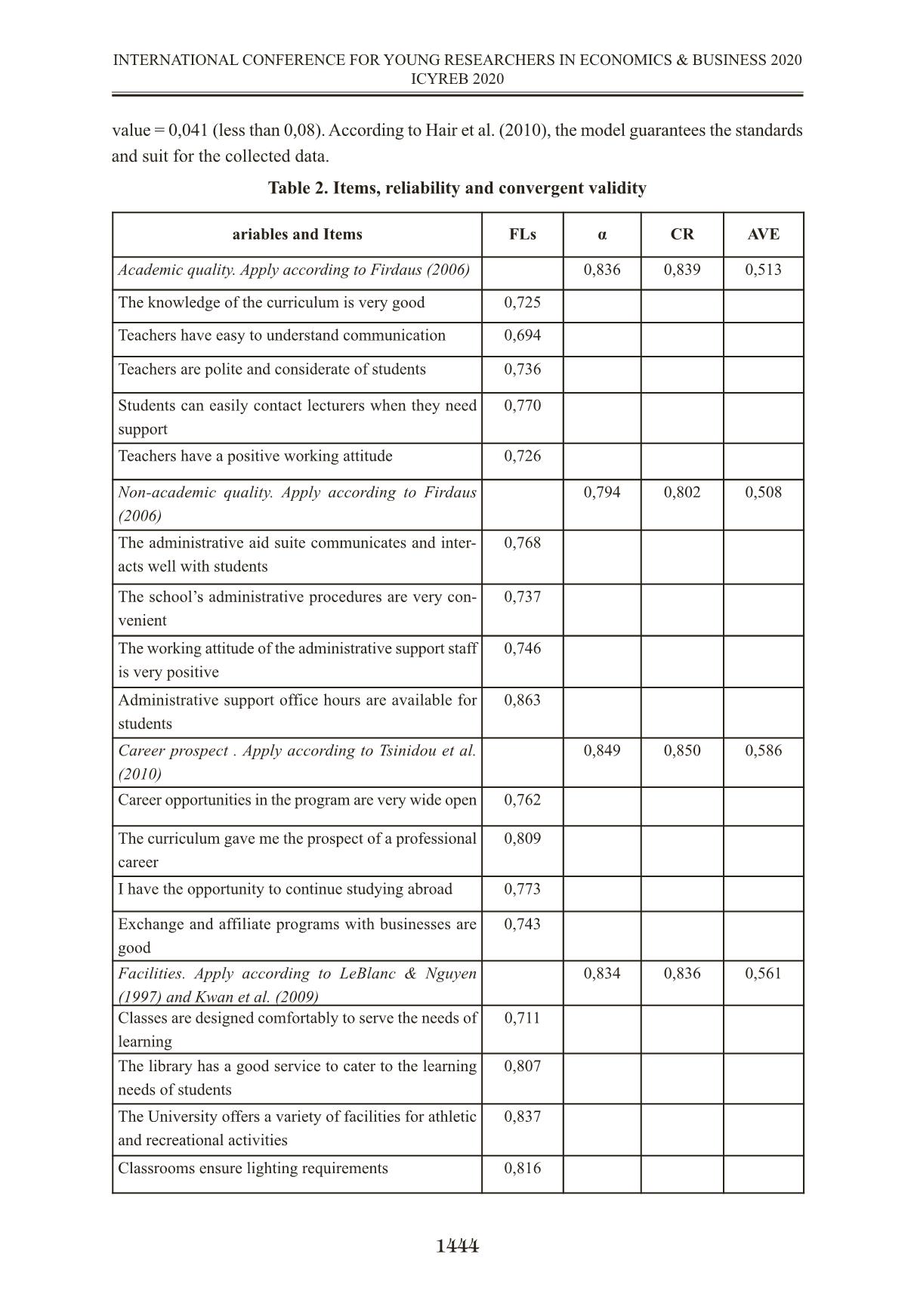
Trang 7
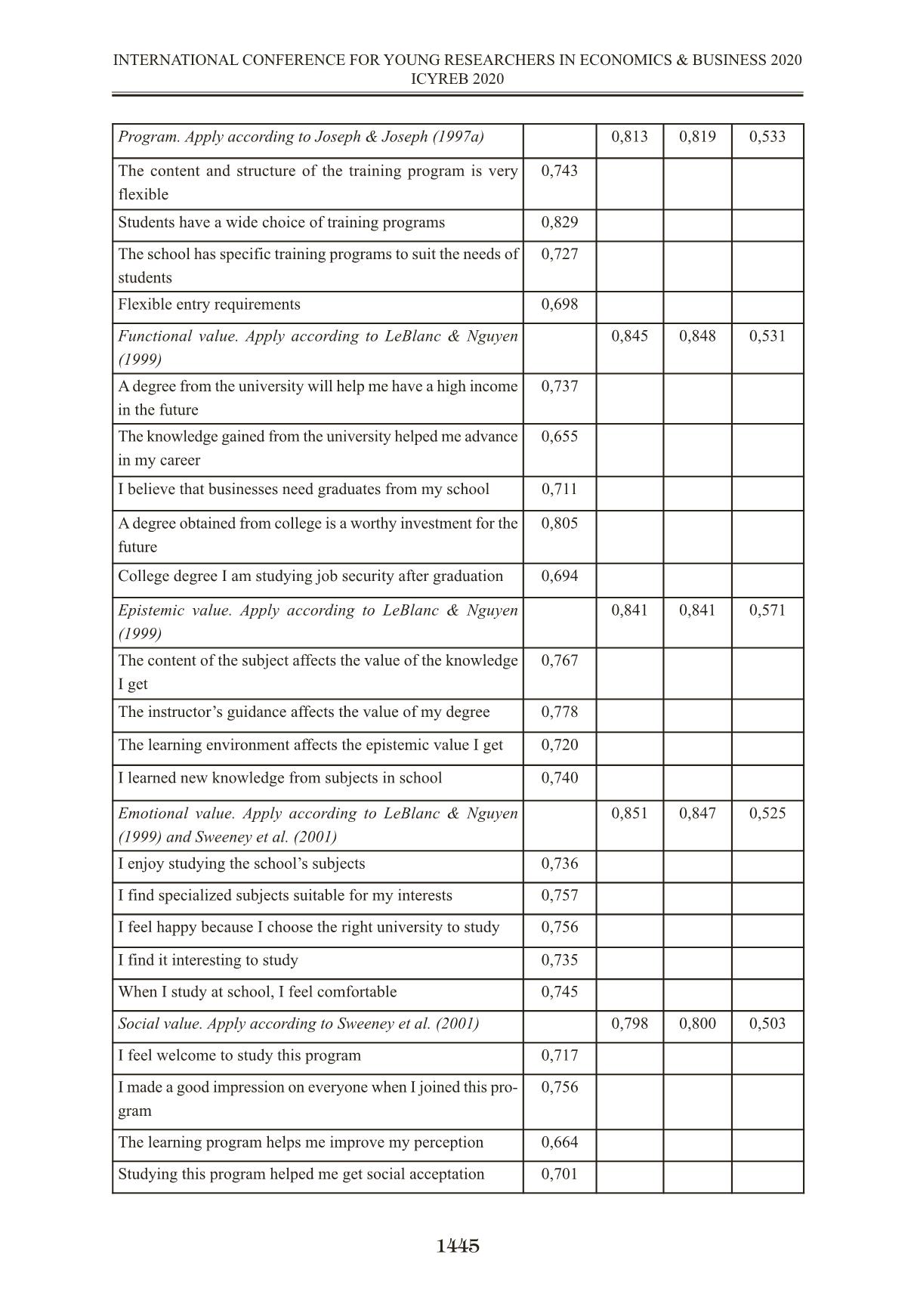
Trang 8
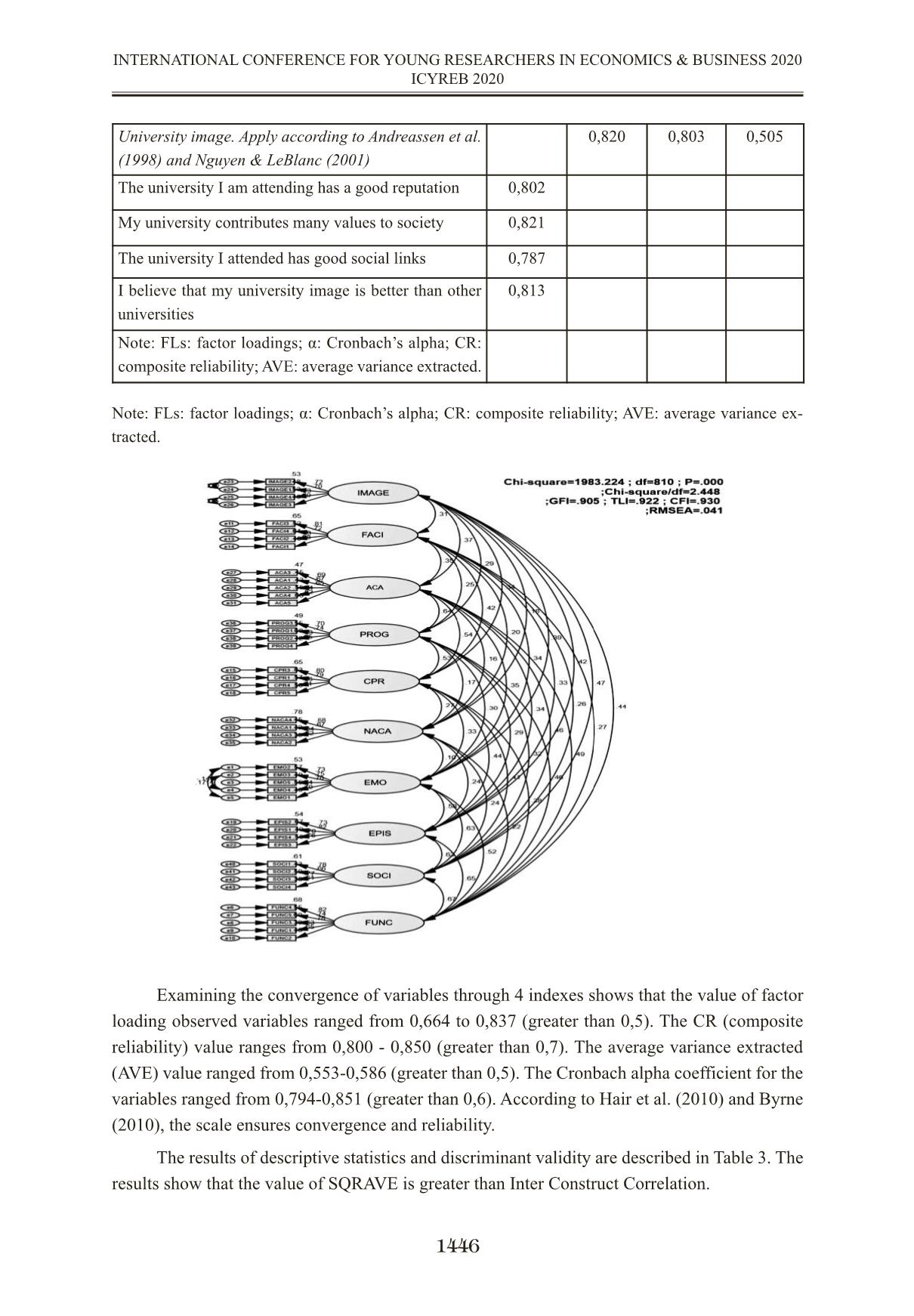
Trang 9
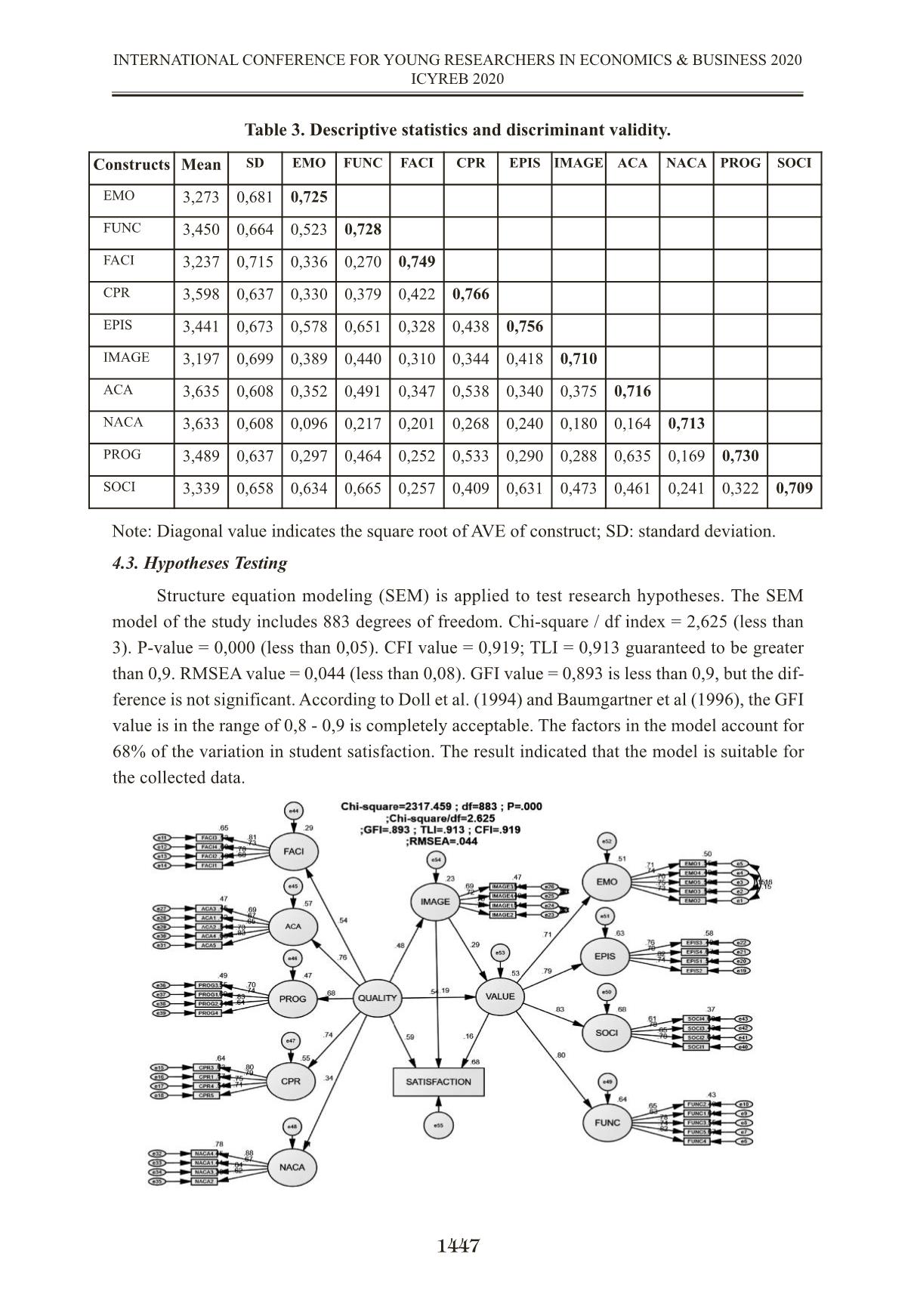
Trang 10
Tải về để xem bản đầy đủ
Tóm tắt nội dung tài liệu: Tác động của hình ảnh, chất lượng và giá trị tới sự hài lòng của sinh viên theo học các chương trình đào tạo quốc tế tại một số Đại học công lập
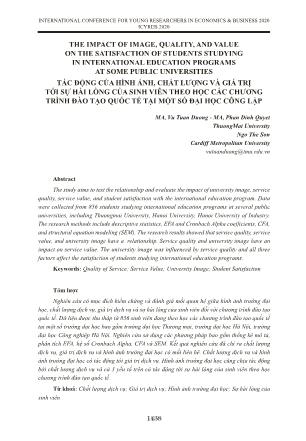
THE IMPACT OF IMAGE, QUALITY, AND VALUE ON THE SATISFACTION OF STUDENTS STUDYING IN INTERNATIONAL EDUCATION PROGRAMS AT SOME PUBLIC UNIVERSITIES TÁC ĐỘNG CỦA HÌNH ẢNH, CHẤT LƯỢNG VÀ GIÁ TRỊ TỚI SỰ HÀI LÒNG CỦA SINH VIÊN THEO HỌC CÁC CHƯƠNG TRÌNH ĐÀO TẠO QUỐC TẾ TẠI MỘT SỐ ĐẠI HỌC CÔNG LẬP MA, Vu Tuan Duong - MA, Phan Dinh Quyet ThuongMai University Ngo The Son Cardiff Metropolitan University vutuanduong@tmu.edu.vn Abstract The study aims to test the relationship and evaluate the impact of university image, service quality, service value, and student satisfaction with the international education program. Data were collected from 856 students studying international education programs at several public universities, including Thuongmai University, Hanoi University, Hanoi University of Industry. The research methods include descriptive statistics, EFA and Cronbach Alpha coefficients, CFA, and structural equation modeling (SEM). The research results showed that service quality, service value, and university image have a relationship. Service quality and university image have an impact on service value. The university image was influenced by service quality and all three factors affect the satisfaction of students studying international education programs. Keywords: Quality of Service; Service Value; University Image; Student Satisfaction Tóm lược Nghiên cứu có mục đích kiểm chứng và đánh giá mối quan hệ giữa hình ảnh trường đại học, chất lượng dịch vụ, giá trị dịch vụ và sự hài lòng của sinh viên đối với chương trình đào tạo quốc tế. Dữ liệu được thu thập từ 856 sinh viên đang theo học các chương trình đào tạo quốc tế tại một số trường đại học bao gồm trường đại học Thương mại, trường đại học Hà Nội, trường đại học Công nghiệp Hà Nội. Nghiên cứu sử dụng các phương pháp bao gồm thống kê mô tả, phân tích EFA, hệ số Cronbach Alpha, CFA và SEM. Kết quả nghiên cứu đã chỉ ra chất lượng dịch vụ, giá trị dịch vụ và hình ảnh trường đại học có mối liên hệ. Chất lượng dịch vụ và hình ảnh trường đại học có tác động tới giá trị dịch vụ. Hình ảnh trường đại học cũng chịu tác động bởi chất lượng dịch vụ và cả 3 yếu tố trên có tác động tới sự hài lòng của sinh viên theo học chương trình đào tạo quốc tế. Từ khoá: Chất lượng dịch vụ; Giá trị dịch vụ; Hình ảnh trường đại học; Sự hài lòng của sinh viên 1438 INTERNATIONAL CONFERENCE FOR YOUNG RESEARCHERS IN ECONOMICS & BUSINESS 2020 ICYREB 2020 1. Introduction International cooperation is gradually becoming an inevitable trend in higher education. This direction helps universities in Vietnam to accelerate the internationalization process through learning and accessing advanced values to develop. The international education program is becoming a solution that shows many advantages when harmonizing the interests of stakeholders including universities of Vietnam, foreign universities, and students. Besides, international education programs have received attention in recent years and are gradually becoming a significant source of income universities. A large number of researches in higher education have mentioned the quality and value of service around the world. Some examples are Damme (2002), Bremer & Van der Wende (1997), McBurnie & Ziguras (2006), David Coleman (2003). The international education programs are increasing in both quantity and quality in Vietnam. There are about 400 international education programs with more than 30 countries around the world being deployed. These programs are also very diverse and sending lecturers from cooperating universities to teach, training model 2 + 2 (2 years of study in Vietnam and the same time studying at the foreign university) or 3 + 1 (last year of internship at the cooperating university) are also familiar. The flexibility in the training form of these programs partly meets the needs and desires of students and their families. But the international education training program also faces many controversial issues such as the quality of training, the value of the cost, or foreign language standards and solutions to these situations. From the mentioned issues, following studies on higher education services in Vietnam in the past by some researches such as Thao H.T.P et al (2007). This study is conducted to test the relationship between the quality; value; image; satisfaction of students with the higher education services of international education programs as well as assessing the current situation of these programs from the perspective of students, giving policy implications for universities to improve student satisfaction. 2. Theoretical grounds and research hypotheses 2.1. Student satisfaction with higher education services and measurement methods Customer satisfaction in studies is often approached with two factors: perception and expectation. Customer satisfaction occurs when the perception is not less than expected. Satisfaction is their response to the perceiv ... value = 0,919; TLI = 0,913 guaranteed to be greater than 0,9. RMSEA value = 0,044 (less than 0,08). GFI value = 0,893 is less than 0,9, but the dif- ference is not significant. According to Doll et al. (1994) and Baumgartner et al (1996), the GFI value is in the range of 0,8 - 0,9 is completely acceptable. The factors in the model account for 68% of the variation in student satisfaction. The result indicated that the model is suitable for the collected data. 1447 INTERNATIONAL CONFERENCE FOR YOUNG RESEARCHERS IN ECONOMICS & BUSINESS 2020 ICYREB 2020 Constructs Mean SD EMO FUNC FACI CPR EPIS IMAGE ACA NACA PROG SOCI EMO 3,273 0,681 0,725 FUNC 3,450 0,664 0,523 0,728 FACI 3,237 0,715 0,336 0,270 0,749 CPR 3,598 0,637 0,330 0,379 0,422 0,766 EPIS 3,441 0,673 0,578 0,651 0,328 0,438 0,756 IMAGE 3,197 0,699 0,389 0,440 0,310 0,344 0,418 0,710 ACA 3,635 0,608 0,352 0,491 0,347 0,538 0,340 0,375 0,716 NACA 3,633 0,608 0,096 0,217 0,201 0,268 0,240 0,180 0,164 0,713 PROG 3,489 0,637 0,297 0,464 0,252 0,533 0,290 0,288 0,635 0,169 0,730 SOCI 3,339 0,658 0,634 0,665 0,257 0,409 0,631 0,473 0,461 0,241 0,322 0,709 The research hypothesis testing results showed that all research hypotheses are supported. The results show that service quality is the strongest factor affecting student satisfaction with the b = 0,592, followed by the image of the university with the b = 0,187. The service value affects student satisfaction with b = 0,156. Service quality also shows a great impact on the image of the university with the b = 0,481. For the service value, the university image affects this factor with the b = 0,288 while service quality impacts the b = 0,544. Table 4. SEM (structural equation modeling) results and hypotheses testing. 5. Discussion, conclusions and proposals based on research findings 5.1. Discussion The research results have verified the relationship between quality, value, image, and cus- tomer satisfaction in the service industry. However, when comparing with the results of research on higher education, the research has some new points. According to LeBlanc and Nguyen (2001), the image of the university has no impact on student satisfaction. In this study, results have shown that the university image has a significant effect on student satisfaction. This situation can be ex- plained by the trend of developing the university image to grow to attract students of universities on a global scale. In the context of industrial revolution 4.0, the development of communication creates favorable conditions to promote the image of the university to students as well as the so- ciety and also creates conditions for learners to easily have got information about the university that they are interested. Therefore, the image of the university became an important factor affect- ing student satisfaction. According to Thao H.T.P and Trong. H (2006) on the impact of service value and quality on student satisfaction with other research, the subject is students of Economics University of Ho Chi Minh City. Ho Chi Minh pointed out service value has a stronger impact on customer satisfaction than quality with service. But the above research results have shown 1448 INTERNATIONAL CONFERENCE FOR YOUNG RESEARCHERS IN ECONOMICS & BUSINESS 2020 ICYREB 2020 Hypotheses b S.E. C.R. P Findings H1: Service Quality g Service Value 0,544 0,078 8,425 *** Supported H2: Service Quality g University Image 0,481 0,088 8,522 *** Supported H3: Service Quality g Student Satisfaction 0,592 0,108 9,728 *** Supported H4: Service Value g Student Satisfaction 0,156 0,068 3,353 *** Supported H5: University Image g Service Value 0,288 0,037 6,060 *** Supported H6: University Image g Student Satisfaction 0,187 0,040 5,244 *** Supported Note: *** p < 0.001; S.E.: standard error. that service quality is the factor that strongly affects the satisfaction of students enrolled in inter- national training programs at 3 surveyed public universities. The difference in study subjects, particularly in this study respondents who were enrolled in an international education training program instead of students enrolled in a general program was part of the explanation for the dif- ference in perception. But compared with the scale of the study Thao H.T.P and Trong.H (2006), the scale in this study has developed and added in the factor of service quality. Career prospects, academic quality are complementary and important to service quality. Compared with the higher education service scale of Thao.H.T.P and Trong. H, which only includes 3 factors including the support, training, and facilities, the quality of service of this research has been more detailed. In particular, career prospects and academic quality are two factors that are highly appreciated in terms of approaching students because international education programs have shorter training times than general programs and highly qualified lecturers from developing countries. The ma- jority of international education programs also focus on practical skills that can help students gain advantages in future career development. Therefore, service quality is felt relatively clearly from the student’s point of view. The factors that make up the service value have a relatively bal- anced impact, the social value having the greatest impact also partly reflects the reality when in- ternational education programs have high tuition fees as well as high quality, many advantages will have a positive impact on the social image of students. 5.2. Conclusion, Implication and Limitation Some of the conclusions drawn from the research results include. Firstly, service quality, service value, and university image have shown an influence on student satisfaction when study- ing in international education programs. The service quality has the greatest impact, followed by the university image. The service value has the lowest impact. Secondly, academic quality and career prospects are important factors in service quality. Social value has become the most im- portant factor in terms of student assessment of service value. Thirdly, non-academic facilities and quality have a much lower impact than the factors constituting service quality. Based on the research results, several recommendations to help universities improve student satisfaction when attending international education programs. Firstly, besides improving all 3 factors of service quality, service value, and university image, there is a need to pay more attention to the develop- ment of service value, which is gradually showing the importance of business activities. Cus- tomers tend to be willing to pay for a product or service that they consider to be of high value. Therefore, the service value at research universities has not shown a large role in student satis- faction. Secondly, the facilities and non-academic quality need to be improved to suit the costs and tuition of students enrolled in international education programs. Thirdly, to continue to pro- mote the outstanding advantages of academic quality and career prospects. These two factors will not only improve the quality, value, and image of international education programs but also very important to the general development of universities. The research still has some limitations due to limited resources and research conditions. Firstly, the research has not been able to conduct multi-group tests to discover the differences according to criteria such as gender, age, psychology, and interest in the subject. Secondly, the 1449 INTERNATIONAL CONFERENCE FOR YOUNG RESEARCHERS IN ECONOMICS & BUSINESS 2020 ICYREB 2020 research sample was selected by the convenient sampling method, so there is not remarkably ob- jectivity. Thirdly, measuring satisfaction with a single question can evaluate incorrectly student satisfaction. REFERENCES Andreassen. W, T. and Lindestad, B. (1998), “Customer loyalty and complex services: The impact of corporate image on quality, customer satisfaction and loyalty for customers with vary- ing degrees of service expertise”, International Journal of Service Industry Management, Vol. 9 No. 1, pp. 7-23 Asunción Beerli Palacio, Gonzalo Díaz Meneses, Pedro J. Pérez Pérez, (2002), “The con- figuration of the university image and its relationship with the satisfaction of students”, Journal of Educational Administration, Vol. 40 Issue: 5, pp.486-505, Baumgartner, H., Homburg, C.(1996): “Applications of Structural Equation Modeling in Marketing and Consumer Research: a review”. International Journal of Research in Marketing 13(2), 139-161. Byrne, B. M. (2010). “Multivariate applications series.Structural equation modeling with AMOS: Basic concepts, applications, and programming (2nd ed.)”. Routledge/Taylor & Francis Group. Cheng, Y.C., (1996), “The pursuit of school effectiveness: Theory, policy and research”. Hong Kong: The Hong Kong Institute of Educational Research, The Chinese University of Hong Kong. Coleman, David. “Quality assurance in transnational education.” Journal of Studies in International Education 7.4 (2003): 354-378. Cronin Jr, MK Brady, GTM Hult (2000), “Assessing the effects of quality, value, and cus- tomer satisfaction on consumer behavioral intentions in service environments”, Journal of re- tailing, Volume 76, Issue 2, Summer 2000, Pages 193-218 Cronin, J.J. and Taylor, S.A. (1992), “Measuring service quality: re-examination and ex- tension”, Journal of Marketing, Vol. 9 No. 3, pp. 55-68. Doll, W.J., Xia, W., Torkzadeh, G.(1994), “A confirmatory factor analysis of the end-user computing satisfaction instrument”, MIS Quarterly 18(4), 357–369. Doyle, Mona. (1984), “New Ways of Measuring Value,” Progressive Grocer-Value, Exec- utive Report: 15-19. Firdaus, A., (2006). “The development of HEdPERF: a new measuring instrument of serv- ice quality for the higher education sector”. International Journal of Consumer Studies, 30(6), pp.569-81. Fujun Lai , Mitch Griffin, Barry J. Babin (2009), “How quality, value, image, and satis- faction create loyalty at a Chinese telecom”, Journal of Business Research 62 (2009) 980–986 1450 INTERNATIONAL CONFERENCE FOR YOUNG RESEARCHERS IN ECONOMICS & BUSINESS 2020 ICYREB 2020 Gaston LeBlanc and Nha Nguyen (1999), “Listening to the customer’s voice: examining perceived service value among business college students”, The International Journal of Educa- tional Management 13/4, 187-198 Ghobadian, A., Speller, S., Jones, M., (1994). “Service quality concepts and models”. Int. J. Qual. Reliability Manage. 11, 43–66 Hair, J., Anderson, R., Tatham, P., and Black, W. (2006), “Multivariate Data Analysis”, 6th ed., Prentice- Hall, Upper Saddle River, N.J. Hair, J.F., Anderson, R.E., Babin, B.J. & Black, W.C. (2010), “Multivariate Data Snalysis: A global Perspective”, Upper Saddle River, Pearson, N.J., USA. Hauser, John. R. and Glen Urban (1986), “The Value Priority Hypotheses for Consumer Budget Plans,” Journal of Consumer Research, 12 (March): 446—462. Hill, Y., Lomas, L. and MacGregor, J., (2003), “Students’ perceptions of quality in higher education”. Quality Assurace in Education, 14(1/2), pp.15-20. Hoàng Thị Phương Thảo (2012), “Xây dựng hình ảnh trường đại học dựa trên chất lượng dịch vụ - Trường hợp Đại học Kinh Tế Tp. HCM”, Tạp chí Tạp chí Phát triển Kinh Tế, số 260, tr. 47-56 Hoàng Thị Phương Thảo & Hoàng Trọng (2006), “Giá trị và chất lượng dịch vụ trong giáo dục đại học nhìn từ góc độ sinh viên”, Tạp chí Phát Triển Kinh Tế, tr. 38- 43. Joseph, M. and Joseph, B., (1997a). “Service quality in education: a student perspective”. Quality Assurance in Education, 5(1), pp.15-21. Kazoleas, D., Kim, Y., & Moffit, M. (2001). “Institutional image: A case study.” Corporate Communications, 6 (4), 205-16. Kennedy, S. H. (1977). “Nurturing corporate images”. European Journal of marketing. Kotler, P. and Fox, K. (1995), “Strategic Marketing for Educational Institutions”, 2nd ed., Prentice-Hall, Englewood Cliffs, NJ. Kui-Son Choi, Woo-Hyun Cho, Sunhee Lee, Hanjoon Lee, Chankon Kime (2004), “The relationships among quality, value, satisfaction and behavioral intention in health care provider choice: A South Korean study” Journal of Business Research 57 (2004) 913–921 Kwan, P.Y.K. and Ng, P.W.K., (1999). “Quality indicators in higher education - comparing Hong kong and China’s students”. Managerial Auditing Journal, 14(1/2), pp.20-27. LeBlanc, G. and Nguyen, N., (1997). “Searching for excellence in business education: an exploratory study of customer impressiions of service quality”. The International Journal of Ed- ucation Management, 11(2), pp.72-79. Lewis, R.C. and Booms, B.H., (1983), “The marketing aspects of service quality. In Berry, L., Shostack, G. and Upah, G. (Eds), ed”. Emerging Perspectives on Services Marketing. Chicago: American Marketing. pp.99-107. 1451 INTERNATIONAL CONFERENCE FOR YOUNG RESEARCHERS IN ECONOMICS & BUSINESS 2020 ICYREB 2020 McBurnie, Grant, and Christopher Ziguras. “Transnational education: Issues and trends in offshore higher education”. Routledge, 2006. Nguyễn Bách Khoa & Nguyễn Hoàng Việt (2014), “Mô hình và khung thang đo chất lượng và giá trị các loại dịch vụ ở Việt Nam”, Tạp chí Khoa Học Thương Mại. Nha Nguyen and Gaston LeBlanc (2001), “Image and reputation of higher education in- stitutions in students’ retention decisions”, The International Journal of Educational Management 15/6, 303±311 Oliver, R.L & Desarbo, W.S, W. S. (1989), “Processing of the satisfaction response in con- sumption: a suggested framework and research proposition”, Journal of Consumer Satisfaction, Dissatisfaction and Complaining Behavior, 2, pp. 1–16. Oliver, R.L. (1997), “Satisfaction: A Behavioral Perspective on the Consumer”, The Mc- Graw-Hill Companies, Inc., New York. Parasuraman, A., Zeithaml, V.A and Berry, L.L. (1988), “A conceptual model of service quality and its implications for future research”, Journal of Marketing, Vol. 49, pp. 41- 50. Sweeneya & Soutarb (2001), “Consumer perceived value: The development of a multiple item scale”, Journal of Retailing 77 (2001) 203–220 Tsinidou, M., Gerogiannis, V. and Fitsilis, P., (2010). “Evaluation of the factors that de- termine quality in higher education: an empirical study”. Quality Assurance in Education, 18(3), pp.227-44. Van Damme, Dirk. “Higher education in the age of globalization.” Globalization and the market in higher education (2002): 21-35. Van der Wende, Marijk (1997), “Internationalising the curriculum in Dutch higher edu- cation: An international comparative perspective.” Journal of studies in international education 1.2 : 53-72. Zeithaml, V.A. and Bitner, M.J. (1996), Services Marketing, McGraw- Hill, Singapore. 1452 INTERNATIONAL CONFERENCE FOR YOUNG RESEARCHERS IN ECONOMICS & BUSINESS 2020 ICYREB 2020
File đính kèm:
 tac_dong_cua_hinh_anh_chat_luong_va_gia_tri_toi_su_hai_long.pdf
tac_dong_cua_hinh_anh_chat_luong_va_gia_tri_toi_su_hai_long.pdf

